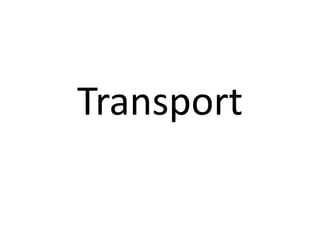Transport in plants.pptx
•Download as PPTX, PDF•
0 likes•15 views
biology A level
Report
Share
Report
Share

Recommended
Recommended
More Related Content
Similar to Transport in plants.pptx
Similar to Transport in plants.pptx (20)
2.2.1.2 functions of the cell membrane UEC Senior 1 Biology 独中高一生物 

2.2.1.2 functions of the cell membrane UEC Senior 1 Biology 独中高一生物
CHAPTER 3: MOVEMENT OF SUBSTANCES ACROSS THE PLASMA MEMBRANE

CHAPTER 3: MOVEMENT OF SUBSTANCES ACROSS THE PLASMA MEMBRANE
Recently uploaded
APM Welcome
Tuesday 30 April 2024
APM North West Network Conference, Synergies Across Sectors
Presented by:
Professor Adam Boddison OBE, Chief Executive Officer, APM
Conference overview:
https://www.apm.org.uk/community/apm-north-west-branch-conference/
Content description:
APM welcome from CEO
The main conference objective was to promote the Project Management profession with interaction between project practitioners, APM Corporate members, current project management students, academia and all who have an interest in projects.APM Welcome, APM North West Network Conference, Synergies Across Sectors

APM Welcome, APM North West Network Conference, Synergies Across SectorsAssociation for Project Management
God is a creative God Gen 1:1. All that He created was “good”, could also be translated “beautiful”. God created man in His own image Gen 1:27. Maths helps us discover the beauty that God has created in His world and, in turn, create beautiful designs to serve and enrich the lives of others.
Explore beautiful and ugly buildings. Mathematics helps us create beautiful d...

Explore beautiful and ugly buildings. Mathematics helps us create beautiful d...christianmathematics
Recently uploaded (20)
Call Girls in Dwarka Mor Delhi Contact Us 9654467111

Call Girls in Dwarka Mor Delhi Contact Us 9654467111
Kisan Call Centre - To harness potential of ICT in Agriculture by answer farm...

Kisan Call Centre - To harness potential of ICT in Agriculture by answer farm...
APM Welcome, APM North West Network Conference, Synergies Across Sectors

APM Welcome, APM North West Network Conference, Synergies Across Sectors
Web & Social Media Analytics Previous Year Question Paper.pdf

Web & Social Media Analytics Previous Year Question Paper.pdf
Measures of Central Tendency: Mean, Median and Mode

Measures of Central Tendency: Mean, Median and Mode
9548086042 for call girls in Indira Nagar with room service

9548086042 for call girls in Indira Nagar with room service
Explore beautiful and ugly buildings. Mathematics helps us create beautiful d...

Explore beautiful and ugly buildings. Mathematics helps us create beautiful d...
Presentation by Andreas Schleicher Tackling the School Absenteeism Crisis 30 ...

Presentation by Andreas Schleicher Tackling the School Absenteeism Crisis 30 ...
Transport in plants.pptx
- 1. Transport
- 2. Why do multicellular organisms need transport systems? • Too big so not all of their cells have contact with the external environment. • All organisms need to exchange substances with their environment - take in needed molecules and get rid of waste.
- 3. Surface area to volume ratio
- 4. Transpiration • What do you remember?
- 5. • It is a consequence of gas exchange
- 6. Investigating factors affecting transpiration rate • Presentations
- 7. Dicotyledonous plants • Distribution of xylem and phloem Root
- 8. •Stem
- 9. Leaves
- 10. Xylem • Transports water • Supports plant Two types: Vessels – no end walls Tracheids – pits in end walls
- 11. • Cellulose cell wall strengthened with lignin
- 12. Phloem • Transporting organic substances • Sieve tube elements join end to end • Sieve plates between • Nucleus and cytoplasm pushed to side
- 13. • Kept alive by companion cells • Lots of mitochondria • Connected to sieve tube by plasmodesmata
- 14. Movement of water • From cell to cell – down a water potential gradient. • From cell to environment - first by osmosis then diffusion
- 15. Movement of water from soil to xylem
- 16. Symplastic pathway • Through the cytoplasm and the vacuole • Entering adjacent cells through plasmodesmata or cell walls
- 17. Apoplastic Pathway • Moves through the cell wall
- 18. Casparian strip • In the stele the cells have a thick, waterproof band of suberin in cell wall • Apoplastic pathway stopped. • This helps with root pressure.
- 19. Roots to leaves • Mass flow due to cohesion and adhesion • Hydrostatic pressure (transpiration decreases pressure at top) • Root pressure (increases pressure at bottom) – active secretion of solutes in to the xylem.
- 20. Role of ions in plants • Nitrates • Magnesium
- 22. Translocation • Food is transported from source to sink • Mainly sucrose • Actively pumped into the sieve tubes at the source • Water follows by osmosis, creating high pressure. • Sugar is then removed by active transport, and water again by osmosis, lowering the pressure in the sieve tube at the sink.
- 24. Sugar Loading and Unloading • There are two known mechanisms • In one, it then enters the phloem by attaching to sucrose transporter proteins embedded in the plasma membranes of the sieve elements and companions cells. • In the second mechanism, sucrose enters through plasmodesmata • they unload from the phloem either through plasmodesmata or by crossing from one cell to another across the cell walls.
- 25. Loading • Hydrogen ions are pumped out of the companion cell in to the source cell • Hydrogen ions flow back by diffusion through a carrier protein that also carries sucrose. • High concentration of sucrose in companion cell causes sucrose to flow into phloem through plasmodesmata.
Editor's Notes
- Nitrates provide the nitrogen plants need to construct such vital molecules as amino acids and nucleic acids (DNA and RNA). Also some of the vitamins. Lack of nitrates means stunted growth, low yields, yellow leaves. Magnesium is the ion that's vital to chlorophyl function and photosynthesis. Without it leaves turn yellowish and/or red orange in colour, shrivel and die.